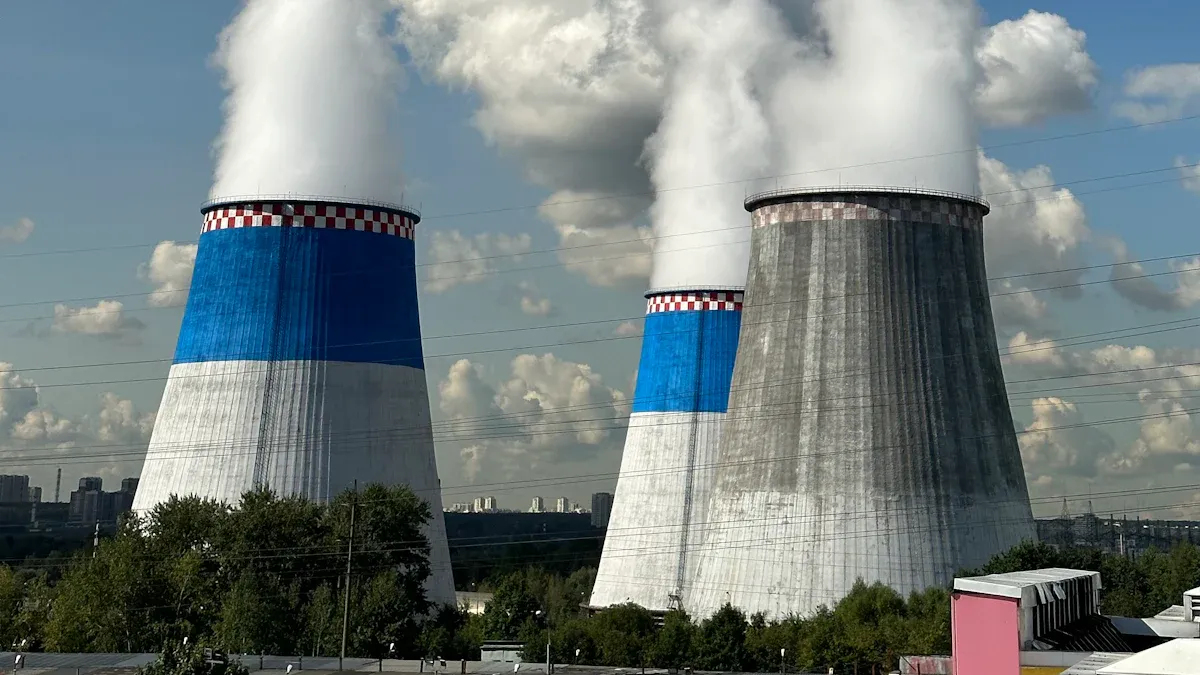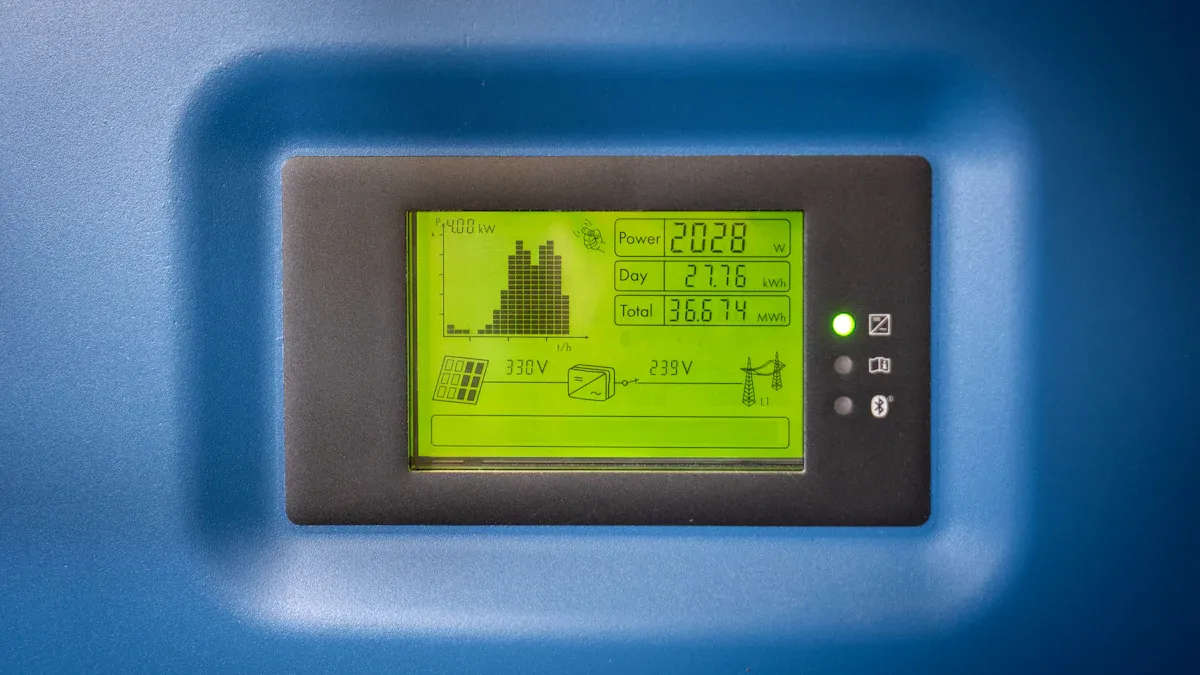The Environmental Benefits of Low-GWP Refrigerants in Water Chillers

Switching to low-GWP refrigerants helps cut harmful gas emissions. These refrigerants are important for fighting climate change. They also help cooling systems meet eco-friendly goals. In water chillers, they reduce emissions and save energy. This change prepares you for 2025 rules and supports sustainability. Using low-GWP refrigerants helps protect the Earth and its future.
Key Takeaways
Using low-GWP refrigerants cuts harmful gases and helps the planet.
These refrigerants save energy in chillers, lowering bills and pollution.
They get your cooling systems ready for future rules and green goals.
Low-GWP refrigerants make chillers work better and last longer, needing fewer fixes.
Choosing low-GWP refrigerants can bring eco-friendly customers and boost business.
Understanding Low-GWP Refrigerants
What Are Low-GWP Refrigerants?
Low-GWP refrigerants are cooling substances that cause less global warming. GWP stands for Global Warming Potential. It shows how much heat a gas traps compared to carbon dioxide. A lower GWP means the gas is better for the environment. These refrigerants are often made from hydrofluoroolefins (HFOs) or natural materials like ammonia and carbon dioxide.
You can find low-GWP refrigerants in many cooling systems, like water chillers. They are a greener choice than older refrigerants, which harm the planet. Choosing low-GWP refrigerants helps cut greenhouse gases and supports eco-friendly actions.
Environmental Advantages of Low-GWP Refrigerants
Switching to low-GWP refrigerants has many environmental benefits. First, they release fewer harmful gases into the air. This helps slow global warming and protects nature.
Second, these refrigerants often use energy more efficiently. Cooling systems like water chillers need less power to run. Using less energy means fewer carbon emissions from power plants. Also, many low-GWP refrigerants are non-toxic and safer for the ozone layer, making them better for Earth.
Tip: Adding low-GWP refrigerants to your cooling systems is an easy way to help the planet.
How Low-GWP Refrigerants Differ From High-GWP Alternatives
Low-GWP refrigerants are different from high-GWP ones in their impact on the environment and their makeup. High-GWP refrigerants, like hydrofluorocarbons (HFCs), trap more heat and worsen climate change. Low-GWP refrigerants are made to reduce this problem.
Another big difference is energy use. Low-GWP refrigerants often make systems like water chillers work better and use less energy. They also meet stricter environmental rules, making them a smart choice for the future. Switching to low-GWP refrigerants helps you follow global green goals and lower your carbon footprint.
The Role of Low-GWP Refrigerants in Water Chillers

Enhancing Energy Efficiency in Water Chillers
Low-GWP refrigerants help water chillers use energy more efficiently. These refrigerants have better cooling properties, making systems work smarter. When a water chiller uses less energy, it lowers electricity use. This saves money on bills and reduces power plant pollution.
Many low-GWP refrigerants also work well with new technologies. These include variable-speed compressors and improved heat exchangers. These features keep chillers running efficiently, even with changing cooling needs. Switching to low-GWP refrigerants saves energy and helps the environment.
Reducing the Carbon Footprint of Cooling Systems
Using low-GWP refrigerants cuts the carbon footprint of cooling systems. High-GWP refrigerants, like HFCs, trap more heat and harm the planet. Low-GWP refrigerants release fewer harmful gases, making them a greener choice.
When combined with energy-saving chillers, they lower emissions even more. For example, chillers with low-GWP refrigerants need less electricity. This means burning fewer fossil fuels for power. The result is fewer direct and indirect emissions, helping industries stay eco-friendly.
Note: Switching to low-GWP refrigerants helps the Earth and meets future rules.
Improving Operational Performance and Longevity
Low-GWP refrigerants improve how water chillers work and last longer. They often run at lower pressures, reducing wear on parts. This means fewer repairs and lower maintenance costs over time.
To keep chillers reliable, focus on key performance factors. The table below shows important things to track for long-lasting chillers:
Metric Type | Description |
|---|---|
Efficiency Ratings | High efficiency ratings (e.g., IPLV, COP) boost performance. |
Maintenance Practices | Regular cleaning and checks keep systems running smoothly. |
Performance Monitoring | Tracking energy use helps find and fix problems early. |
By watching these factors and caring for your chiller, it will work well for years. Low-GWP refrigerants also support smart monitoring tools. These tools help spot issues early and keep cooling steady. This approach extends equipment life and ensures reliable performance.
Regulatory Drivers for Low-GWP Refrigerants in 2025
Global Mandates and Sustainability Goals
Global rules and eco-goals push the use of low-GWP refrigerants. Agreements like the Kigali Amendment aim to cut high-GWP gases. This rule, active since January 2019, reduces hydrofluorocarbons (HFCs) worldwide. In the U.S., the AIM Act requires an 85% cut in HFC production by 2036. These rules encourage industries to switch to greener refrigerants.
The European Union’s F-Gas Regulation also sets strict limits. By 2025, new equipment must use refrigerants with a GWP below 150. Companies like Daikin and Carrier are already following these rules. Daikin supports R-32 as a replacement for R-410A. Carrier has launched R-454B heat pumps before deadlines. These actions show the industry's focus on sustainability.
Regulation | Description |
|---|---|
AIM Act | Cuts U.S. HFC production by 85% by 2036. |
Kigali Amendment | Global HFC controls started in January 2019. |
EU F-Gas Regulation | Limits refrigerants to GWP < 150 by 2025. |
Using low-GWP refrigerants helps meet these rules and supports a greener planet.
Regional Policies and Industry Standards
Local rules and industry guidelines stress low-GWP refrigerants' importance. In North America, the AIM Act sets clear HFC reduction goals. Europe’s F-Gas Regulation limits refrigerant GWP levels strictly. These rules ensure industries adopt eco-friendly practices.
Industry standards also guide refrigerant choices. R-32 and R-454B are popular for their low GWP and system compatibility. For example, R-32 has a lower GWP than R-410A and is used in home and small business cooling. R-454B, with an even lower GWP, replaces R-410A in many systems.
Refrigerant | Applications | Flammability | |
|---|---|---|---|
R-32 | Lower than R-410A | Home and small business cooling | A2L |
R-454B | Very low | Replaces R-410A | A2L |
R-290 | Very low | Small commercial cooling | A3 |
R-744 | Extremely low | Commercial and industrial cooling | N/A |
R-1234yf | Very low | Car AC, chillers | A2L |
Switching to these refrigerants meets local rules and boosts system performance.
Challenges and Opportunities for Compliance
Switching to low-GWP refrigerants has challenges but also benefits. One challenge is the cost of upgrading old systems. Retrofitting older equipment for low-GWP refrigerants can be pricey. Some low-GWP refrigerants are flammable, needing careful handling.
Still, the benefits are worth it. Low-GWP refrigerants save energy and lower costs over time. They help meet rules and avoid fines. More people now prefer eco-friendly cooling solutions. Using low-GWP refrigerants can attract green-minded customers and give you an edge.
Tip: Work with experts in low-GWP refrigerants to make the switch easier.
By solving these challenges and using the benefits, you can follow rules and support a sustainable future.
Real-World Uses of Low-GWP Refrigerants in Water Chillers
Example: Factory Water Chillers
Factories need water chillers to keep machines at the right temperature. One big electronics company switched to low-GWP refrigerants recently. This change cut their greenhouse gas emissions by 30%. It also made their chillers 15% more energy-efficient.
They replaced high-GWP refrigerants with R-1234ze, a low-GWP option. After small changes, the new refrigerant worked well with their equipment. This switch helped them follow environmental rules and save money. This example shows how industries can gain from using eco-friendly refrigerants.
Example: Cooling Systems in Office Buildings
Office buildings use water chillers to keep rooms cool and comfy. A large office in California upgraded to R-32, a low-GWP refrigerant. This change greatly reduced the building's carbon footprint.
The new refrigerant made the chiller work better, especially in hot summers. Energy bills dropped by 20%, and the system needed less fixing. This shows how low-GWP refrigerants can help both the planet and businesses.
Lessons From Early Users
People who started using low-GWP refrigerants early share many benefits. They noticed lower energy use and fewer emissions. They also saved money because their systems worked better and lasted longer.
Some had trouble updating old equipment, but experts helped them. While the upfront cost was high, the long-term benefits were worth it. Switching to low-GWP refrigerants can prepare your systems for the future and help the environment.
Low-GWP refrigerants help lower environmental damage and follow new rules. They make water chillers better by saving energy, reducing pollution, and improving how they work.
Tip: Switching to low-GWP refrigerants helps meet global climate goals. It also keeps your cooling systems dependable and good for the planet.
Using these refrigerants supports a greener future and gets your systems ready for future needs.
FAQ
What does GWP mean, and why is it important?
GWP means Global Warming Potential. It shows how much heat a gas traps compared to carbon dioxide. Using refrigerants with low GWP helps fight climate change and protects nature.
Can you retrofit existing water chillers with low-GWP refrigerants?
Yes, many water chillers can switch to low-GWP refrigerants. Some parts may need changes to work properly. Ask an expert to check your system and suggest the best solution.
Are low-GWP refrigerants safe to use?
Most low-GWP refrigerants are safe if used carefully. Some might be slightly flammable or toxic. Training and safety steps are very important. Always follow the maker's rules and safety guidelines.
How do low-GWP refrigerants improve energy efficiency?
Low-GWP refrigerants cool better because of their special properties. This helps chillers use less energy while staying effective. Lower energy use means smaller bills and less pollution.
What are the costs of switching to low-GWP refrigerants?
Costs depend on whether you upgrade old systems or buy new ones. The starting price might seem high, but energy savings and meeting rules make it worth it over time.
Tip: Start planning early to save money and avoid rushing later.
See Also
CO₂ Cooling: An Eco-Friendly Refrigeration Alternative
Exploring How Water Chiller Units Function Effectively
Exploring Advantages of CO₂ Transcritical Refrigeration Systems
Reasons ARKREF CO₂ Refrigeration Stands Out for Sustainability

